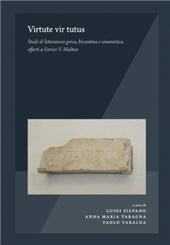"Quella piccola goccia di miele" : migrazione di una parabola dall'Oriente a Bisanzio e da Bisanzio all'Occidente
P. 603-623
It is on the road from the East to Byzantium and from Byzantium to the West that “an extraordinary narrative tradition with a wealth of mature and sophisticated structural solutions passes through and becomes accessible to European scholars and readers”, as Enrico Maltese wrote in one of his best-known works. The historical vocation of Byzantium to play a role of mediation and cultural transmission, “not only in a vertical (diachronic) sense, as a vehicle of the ancient Greek heritage, but also in a horizontal (synchronic) sense”, can similarly be seen in that literary heritage that embodies passages of Jain and Buddhist stories, such as those contained in the Barlaam and Ioasaf, the life of the Buddha transformed into speculum principis, within which a series of ‘novellas' is included.
Most clearly illustrating the Indian origin of the underlying scheme is also the most well-known of them: the Story of the Man in the Ravine, found, among others, in the Mahabharata - though originating from the Buddhist Avadāna - but which, through the Barlaam and Ioasaf, is found in virtually every work of literature, from Zen collections to Baudelaire's diaries. In light of the new methodological approaches provided by recent studies, this paper summarizes the circular peregrination of this “migrant text” in the literary and iconographic space of over two millennia. [Publisher's text]
-
Chapters from the same volume (available individually)
-
Information
ISBN: 9789464753127


